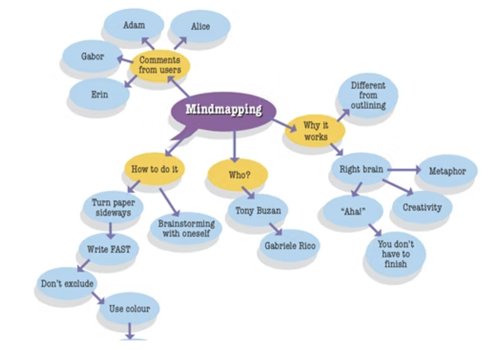Reading time: About 2.5 minutes
Have you ever heard me talk about mindmapping and wondered what all the fuss was about? Here’s an explanation…
I bribed my daughter last week.
When she asked for help with an essay I looked her squarely in the eye and said, “Have you done a mindmap yet?” When, as I expected, she answered no, I agreed to help only if she did a mindmap first.
But why do I insist on blathering on about mindmapping she wanted to know, for about the 100 millionth time.
Over the years, as I’ve engaged in my not-so-subtle proselytizing about mindmapping with family, friends and subscribers, I’ve discovered the world divides rather neatly into four camps. They are:
The uninitiated: People who’ve never heard of mindmapping. They wouldn’t recognize a mindmap if they fell into one.
The unlucky: People who’ve been taught how to mindmap for strategic planning or party organizing but who’ve never been told it’s the single best way to turbo-charge their writing.
The uncomfortable: People who’ve tried mindmapping, found it doesn’t work for them and truly don’t understand what the fuss is all about.
The unmerciful zealots: These are unabashed fans, like me, who’ve found that mindmapping dissolves writer’s block and makes a formerly dreaded task faster and far more pleasurable.
Why do I like mindmapping so much?
1) It’s easy. In fact, I knew how to do it for at least a dozen years before I started using it for writing. Ironically, it had seemed too simple. Too much time in school had taught me that something had to be difficult for it work. The plain truth is, the world doesn’t hand out rules like that. Some things in life are difficult and some are just easy.
Here’s how to do it: Take a piece of blank paper and turn it landscape fashion so you feel the freedom of lots of space. Write your central idea in the middle of the page and draw a circle around it. Then start brainstorming. Write down everything that springs into your brain — no editing, no censoring! (See graphic, above.) Embellish with pictures if you like.
2) It’s inexpensive. While you can buy some software to help you mindmap, you don’t need to. Most frequently, I use a pencil and a piece of paper. My latest innovation in the paper department is an artist’s booklet on a ringed binder. (Not that you need this –- but it’s pretty and it keeps my mindmaps organized and in one place.)
3) It works. Mindmapping makes writing more fun. It gives you access to your deep unconscious where all your best ideas are hiding. It helps you escape the tyranny of just the facts, ma’am and envelopes you into the warm world of stories and metaphors. Mindmaps INSPIRE writing. Outlines almost never do this for reasons I’ve explained before.
If you’re one of the uncomfortables, please know that your irritation likely means you’re doing something wrong. I understand this makes me sound fervent but I hate for you to have to suffer from writer’s block.
Here’s where you may have gone astray: You’re trying to be overly organized (stop fussing about which thought links with which!) You’re staring into space too much (keep your hand moving all the time even if you’re drawing or doodling!) And, finally, you’re not writing the best idea in the centre of the page. To fix this last problem, take your idea for a walk before you start your mindmap and ensure you have anangle rather than just a topic. (I’ll write more about this soon, in a future column.)
If you’re one of the uninitiated or the unlucky you might want to re-read the 17-page electronic booklet on mindmapping I sent you when you subscribed to this newsletter.
And, finally, if you’re one of the unmerciful zealots, well, stop reading and go do a mindmap right now! (By the way, my daughter completed her mindmap in less than fives minutes and had no difficulty writing after that.)


